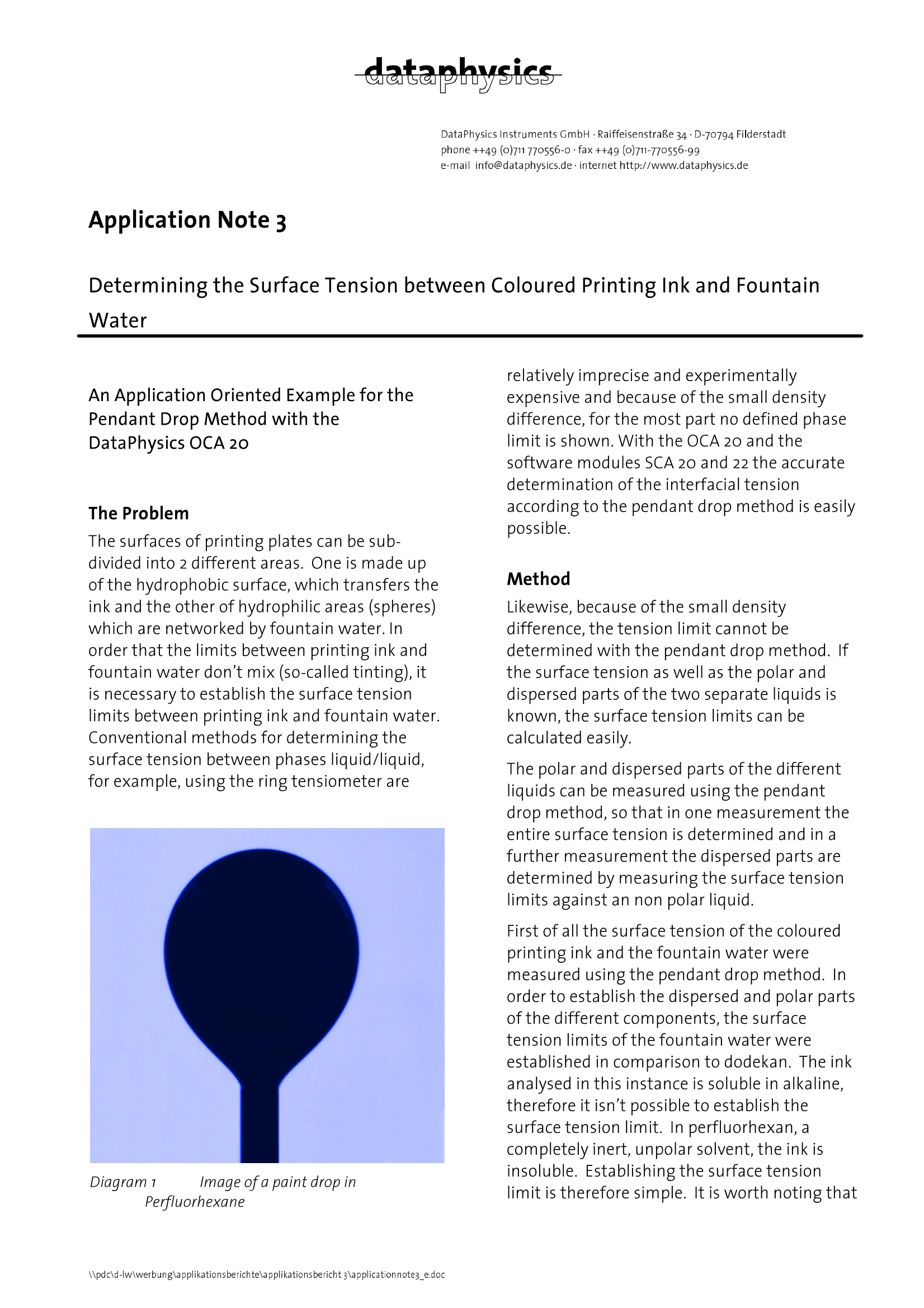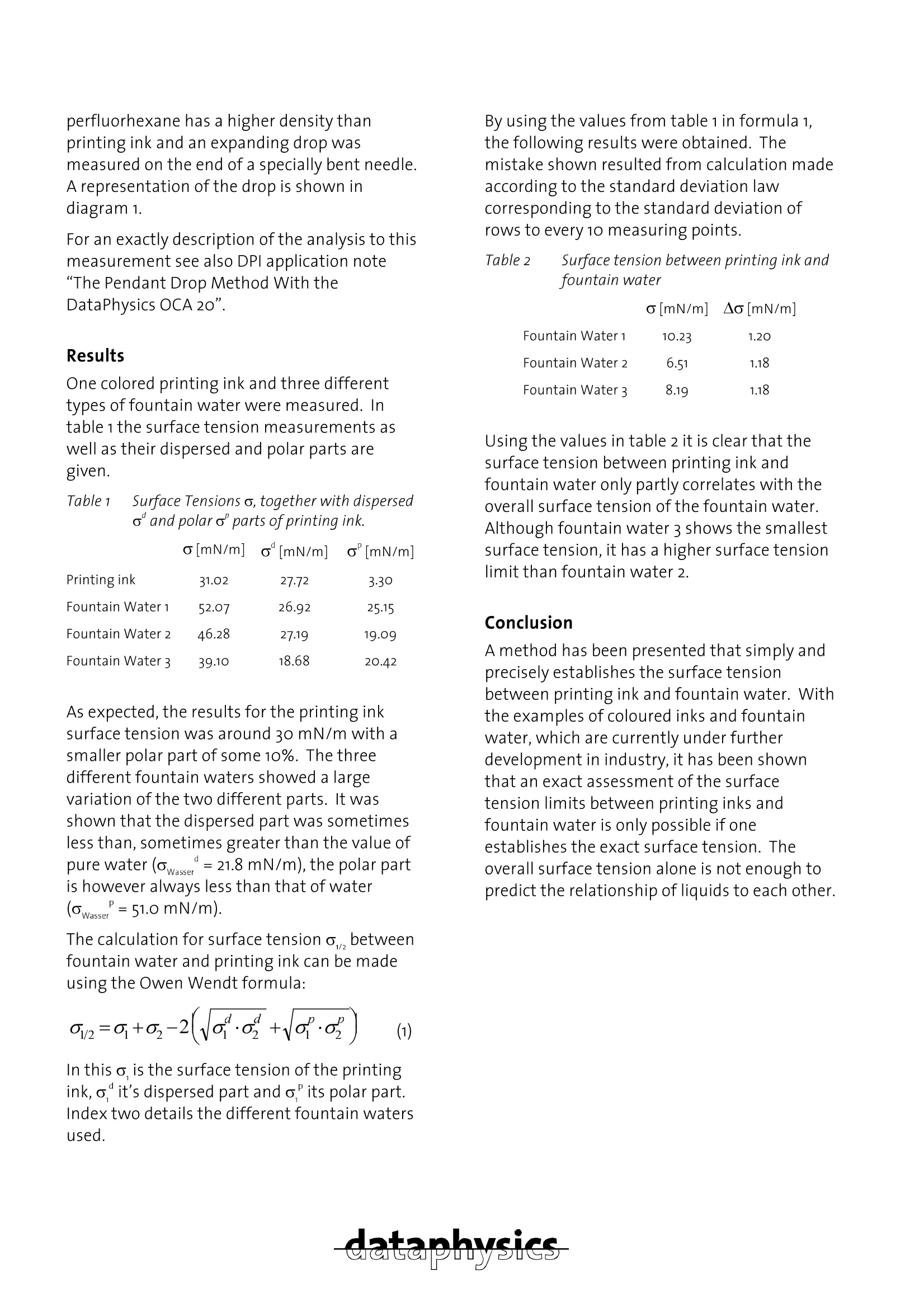
方案详情
文
A method has been presented that simply and precisely establishes the
surface tension between printing ink and fountain water. With the examples
of coloured inks and fountain water, which are currently under further
development in industry, it has been shown that an exact assessment of
the surface tension limits between printing inks and fountain water
is only possible if one establishes the exact surface tension. The over
all surface tension alone is not enough to predict the relationship of
liquids to each other.
方案详情

-dataphysics-\\pdc\d-lw\werbung\applikationsberichte\applikationsbericht 3\applicationnote3_e.doc DataPhysics Instruments GmbH·RaiffeisenstraBe 34·D-70794 Filderstadtphone++49 (0)711 770556-0·fax++49(0)711-770556-99 e-mail info@dataphysics.de·internet http://www.dataphysics.de Application Note 3 Determining the Surface Tension between Coloured Printing Ink and FountainWater An Application Oriented Example for thePendant Drop Method with theDataPhysics OCA 20 The Problem The surfaces of printing plates can be sub-divided into 2 different areas. One is made upof the hydrophobic surface, which transfers theink and the other of hydrophilic areas (spheres)which are networked by fountain water. Inorder that the limits between printing ink andfountain water don’t mix (so-called tinting), itis necessary to establish the surface tensionlimits between printing ink and fountain water.Conventional methods for determining thesurface tension between phases liquid/liquid,for example, using the ring tensiometer are Diagram 1 Image ofa paint drop inPerfluorhexane relatively imprecise and experimentallyexpensive and because of the small densitydifference, for the most part no defined phaselimit is shown. With the OCA 20 and thesoftware modules SCA 20 and 22 the accuratedetermination of the interfacial tensionaccording to the pendant drop method is easilypossible. Method Likewise.because of the small densitydifference, the tension limit cannot bedetermined with the pendant drop method. Ifthe surface tension as well as the polar anddispersed parts of the two separate liquids isknown, the surface tension limits can becalculated easily. The polar and dispersed parts of the differentliquids can be measured using the pendantdrop method, so that in one measurement theentire surface tension is determined and in afurther measurement the dispersed parts aredetermined by measuring the surface tensionlimits against an non polar liquid. First of all the surface tension of the colouredprinting ink and the fountain water weremeasured using the pendant drop method. Inorder to establish the dispersed and polar partsof the different components, the surfacetension limits ofthe fountain water wereestablished in comparison to dodekan. The inkanalysed in this instance is soluble in alkaline,therefore it isn't possible to establish thesurface tension limit. In perfluorhexan, acompletely inert, unpolar solvent, the ink isinsoluble. Establishing the surface tensionlimit is therefore simple. It is worth noting that perfluorhexane has a higher density thanprinting ink and an expanding drop wasmeasured on the end of a specially bent needle.A representation of the drop is shown indiagram 1. For an exactly description of the analysis to thismeasurement see also DPI application note“The Pendant Drop Method With theDataPhysics OCA 20". Results One colored printing ink and three differenttypes of fountain water were measured. Intable 1 the surface tension measurements aswell as their dispersed and polar parts aregiven. Table 1 Surface Tensions o, together with dispersedo"andpolar o"parts of printing ink. Printing ink 31.02 27.72 3.30 Fountain Water1 52.07 26.92 25.15 Fountain Water 2 46.28 27.19 19.09 Fountain Water 3 39.10 18.68 20.42 As expected, the results for the printing inksurface tension was around 30 mN/m with asmaller polar part of some 10%. The threedifferent fountain waters showed a largevariation of the two different parts. It wasshown that the dispersed part was sometimesless than, sometimes greater than the value ofpure water (owasser=21.8 mN/m), the polar partis however always less than that of water(owasser=51.0mN/m). The calculation for surface tension o,,betweenfountain water and printing ink can be madeusing the Owen Wendt formula: In this o is the surface tension of the printingink, o, it’s dispersed part and o,"its polar part.Index two details the different fountain watersused. By using the values from table 1 in formula 1,the following results were obtained. Themistake shown resulted from calculation madeaccording to the standard deviation lawcorresponding to the standard deviation ofrows to every 1o measuring points. Table 2 Surface tension between printing ink andfountain water o[mN/m] 1]A Ao[mN/m] Fountain Water 1 10.23 1.2O Fountain Water 2 6.51 1.18 Fountain Water 3 8.19 1.18 Using the values in table 2 it is clear that thesurface tension between printing ink andfountain water only partly correlates with theoverall surface tension of the fountain water.Although fountain water 3 shows the smallestsurface tension, it has a higher surface tensionlimit than fountain water 2. Conclusion A method has been presented that simply andprecisely establishes the surface tensionbetween printing ink and fountain water. Withthe examples of coloured inks and fountainwater, which are currently under furtherdevelopment in industry, it has been shownthat an exact assessment of the surfacetension limits between printing inks andfountain water is only possible if oneestablishes the exact surface tension. Theoverall surface tension alone is not enough topredict the relationship of liquids to each other.
确定


还剩1页未读,是否继续阅读?
北京东方德菲仪器有限公司为您提供《矿泉水中界面张力检测方案(接触角测量仪)》,该方案主要用于饮用水中综合检测,参考标准--,《矿泉水中界面张力检测方案(接触角测量仪)》用到的仪器有
相关方案
更多








